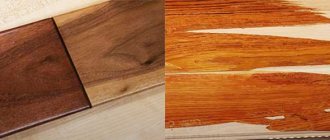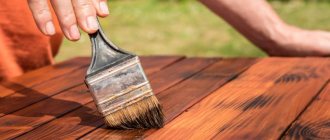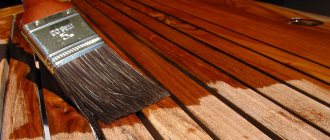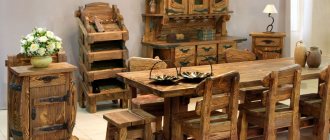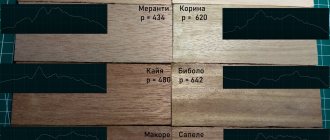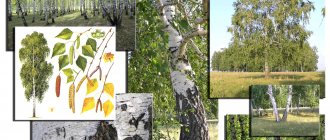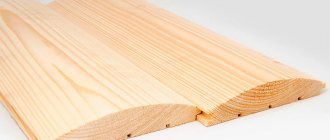Tree under the influence of negative factors Over time they lose their natural attractiveness and deteriorate performance characteristics: they fade under the influence of UV; deformed from excess moisture; rot when pathogenic microflora multiply.
To give a rich shade, preserve the structure, protect against destruction and extend service life , a special wood stain is used. Read more about what types of compositions there are, how to prepare them and what are the features of processing wooden surfaces.
What is stain used for?
Stain, or stain, is a special deep penetration composition that allows you to preserve the natural structure of the wood and give it the necessary shade . It can also be used to treat surfaces made of plywood, fiberboard, chipboard and MDF.
The main difference between stains and decorative enamels and paints is the deep penetration of tinting components , which allow you to color the wood from the inside, maintaining its texture and without forming a protective film on the surface.
You need to stain a tree to achieve the following goals:
- painting wood in a certain color or imitating expensive species;
- protection of wood from rotting and internal destruction due to the negative effects of moisture, infection with mold and pathogenic microorganisms;
- restoration and restoration of old and damaged wooden surfaces;
- giving wood a natural attractiveness;
- increasing strength and weather resistance;
- increasing the service life of the material;
- decoration by combining different shades.
When choosing impregnation, it is important to consider that not all compositions have the above characteristics.
Types and composition
Modern impregnating stains can be classified according to their composition . The following types are distinguished:
- aquatic;
- oil;
- alcohol;
- acrylic;
- waxy.
Water based
Such impregnations are produced in powder form (soluble in water) and ready-made liquid formulations. This is an environmentally friendly and safe product with an impressive range of shades.
Water stain does not have a pronounced odor, so it can be used to treat interior and exterior wooden surfaces. In addition, it is characterized by high elasticity and adhesion to wood .
Despite its safety and practicality, the composition has some disadvantages.
The main one is that it is not suitable for processing wood with a high resin content . This may cause dark spots to appear.
The next drawback is that when painting, wood fibers rise, which entails mandatory surface sanding . To eliminate this drawback, a non-aqueous wood stain is used.
Another disadvantage is a decrease in the moisture-resistant characteristics of wood with prolonged contact with moisture. They are quickly washed out by water, so they are not able to provide reliable protection of the material.
Oil based
Oil stains are based on coloring solutions in linseed oil or drying oil.
They are easy to apply with any available tool and have good resistance to fading, high humidity and temperature changes.
In addition, they do not lift wood fibers or fill them with excess moisture when stained .
Due to its high performance characteristics, this type of composition is suitable for treating structures inside and outside, forming a moisture-resistant protective film.
Thickened stain is diluted using white spirit.
Alcohol based
Impregnations are special solutions consisting of aniline dyes and denatured alcohol (alcohol base). They come in powder form and in the form of ready-made formulations.
Deep penetration of dyes into wood fibers leads to rapid coloring and drying of the surface .
To evenly stain wood with alcohol stain, it is recommended to use a spray gun . This will avoid the appearance of characteristic stains and stains.
Such compositions provide reliable protection of wood from negative atmospheric influences, and therefore have long been used to treat surfaces that are used outdoors .
Important! The main disadvantage of alcohol stains is the presence of a strong chemical odor.
Acrylic and wax based
Acrylic and wax impregnations are practically free of the disadvantages that are characteristic of traditional types . The compositions allow you to paint surfaces in any shade and increase their water-repellent properties.
The stains contain special acrylic resins and natural wax, which create a thin film to protect against the negative effects of external factors.
- Acrylic stains. They are environmentally friendly, fireproof and practical materials designed for various types of wood. They do not have a pronounced chemical odor, dry quickly, and have a wide color palette. To obtain a high staining result, it is better to apply the stain in two layers, the thickness of each of them should not exceed 3-4 mm.
- Wax stains. They are designed for treating painted wooden surfaces. Provide reliable protection from high moisture and temperature changes. The compositions are applied using a soft cloth in a circular rubbing motion.
Application Features
The quality of the decorative layer will be better if the surface is properly prepared before applying the stain. If it has not been previously treated with anything, preparation will only consist of thorough grinding and cleaning of the resulting dust. This step is especially important if a water-based stain will be used. It will get rid of lint that rises when wet. However, sanding may be required after the impregnation has dried, but in this case, not sandpaper or sandpaper, but a coarse cloth, is used to remove lint.
If the tree was previously covered with paints and varnishes, they will have to be removed by any possible means - mechanical or chemical. An exception is made only for wood stained with stain or impregnation - they do not need to be cleaned, and this is unlikely to be possible without removing the top layer. But the tone of the new layer should match the previous one or be darker.
You also need to get rid of greasy stains and dirt, and cracks and fallen knots will have to be puttied.
Sanding the surface before opening with stain Source www.lakma.info
When choosing a painting tool, you should consider:
- type of stain - alcohol and nitro stains are applied only with a spray gun, in other cases you can use hand tools: a foam sponge, a brush, a roller, a cotton swab in a fabric cover. The latter is preferred when using wax compositions;
- surface area – for large volumes it is better to choose a sprayer;
Note! The layer of stain applied with a spray gun is always thicker than that applied with a brush or roller. This must be taken into account, since the thicker the layer, the more saturated the color will be.
- surface quality - if it is not smooth (for example, artificially aged), then fibers and bristles from hand tools may remain on it. Which also forces us to give preference to a sprayer.
It is better to stain such surfaces with a spray Source gidpokraske.ru
How long does it take to dry?
Each type of stain has different drying times , which are indicated on the packaging or in the instructions for the selected composition.
- When applied to a surface, water stains dry from 12 to 20 hours;
- alcohol compositions dry quickly, up to 5-7 minutes. In low temperature or high humidity conditions, drying time may be 30 minutes;
- oil impregnations dry in 1 to 2 days after application;
- acrylic compositions dry within 60 minutes;
- Wax stains dry for 12-14 hours after application.
Step-by-step dyeing technology
Despite the multiple preparatory steps, the direct process of applying stain is not at all complicated. It is performed according to the following scheme:
1. The stain is heated a little to increase the degree of penetration into the wood.
2. A swab, rag or brush is soaked in stain. Strong moisture should not be allowed, otherwise drips and uneven coloring will inevitably occur. When using a sprayer, pour the stain into the tank.
3. Apply stain along the wood fibers. They try to work quickly, without interruptions, to avoid stains. When streaks form, wipe the surface with a soft cloth, “pulling” excess liquid along the fibers. Leave the stain until completely dry.
4. In a similar way, apply several more layers to obtain the desired shade (usually 2-3 layers).
5. Finally, the stain-painted surface is varnished in several layers, sanding each intermediate layer with fine-grained sandpaper.
Color spectrum
In accordance with the international classification, each color is assigned its own code and name .
For example, “pine”, “walnut” or “fruit wood” stain.
To choose a wood stain in a suitable color scheme, you need to carry out a test painting of the wood and take into account:
- natural shade and type of wood subject to processing. Painting with stain can lead to the appearance of new shades;
- the color range stated in the catalogue. Colors under the same code from different manufacturers can produce shades of different depth and saturation on different types of wood. The same composition on pine will look lighter than on red wood. This can be explained by the fact that such wood has a more saturated natural shade;
- quality of stains. Compositions in the same color from different manufacturers can give different coloring effects. Therefore, you should not choose products of dubious quality;
- density of stains. The lower the density, the more the composition is absorbed into the wood. This results in a less saturated and deep shade.
The following colors of water-based wood stains are considered the most popular:
- “oak” – rich brown shade;
- “mahogany” – a noble burgundy shade;
- “pine” – the shade is close to the natural color of the wood;
- “natural” – natural light yellow shade;
- “light walnut” – practically does not change the natural color of the wood, and is used as a protective composition;
- “cherry” – light red and rich burgundy shade;
- “mahogany” – brown with light shades of red;
- “Wenge” – dark shades of brown;
- “larch” – from dark yellow to orange hue.
Creating effects
Alcohol or water stain can create an imitation of the naturalness of the coating without obvious traces of processing. When choosing a material for protection and painting, focus on the desired effect: choose a shade of oak, pine or ebony (as in the photo) - the interior will instantly be ennobled.
Products made from ash or oak do not need to be tinted - leave their structure and shade open, choosing the shade of this species that is as close to nature as possible.
Properly stained wood should retain its natural appearance. Only acrylic or wax stains stand out, the color range of which goes beyond naturalness.
The properties of each type of wood are different. In order not to make a mistake when purchasing, pay attention to the flower palette: the composition is applied to planks of different types, where you can see the final result.
How to make it yourself
You can prepare a simple stain for wood processing at home:
- from plant ingredients;
- from tea and coffee products;
- from chemical components.
Based on plant materials
- Decoction of onion peels to obtain a bright red hue.
- A decoction of walnut peels to obtain a rich brown hue. To do this, the shell is crushed to a powder and boiled for 12 minutes in water. Add 1 tsp to the finished strained broth soda _ To obtain a red tint, potassium bichromate is added instead of soda; for a gray color, vinegar essence is added.
- Decoctions of oak, willow and alder bark give a rich black color.
- A decoction of buckthorn berries will paint the wood an attractive golden color.
From coffee, tea and vinegar essence
- To get a rich brown tint, it is enough to combine natural ground coffee and soda .
- To stain light wood, you can use a strong brew of black tea .
- To obtain a deep black shade, you need to place metal nails in a container and fill them with acetic acid . Leave for 5-7 days in a dark place.
Based on chemical components
- The brown tint is obtained after treating the wood with a solution of slaked lime .
- A deep cherry tint is achieved by applying a solution of potassium permanganate . To do this, you will need 60 g of potassium permanganate, which is diluted with a liter of heated water.
- A rich yellow tint is obtained by treating the surface with a decoction of barberry roots , to which alum is added.
- The herbal color will be obtained by combining 60 g of verdigris and vinegar essence . The mixture is boiled for 10 minutes.
- The dark brown color is obtained by combining wolfberry with copper sulfate . Glauber's salt with these berries gives a red color, and soda gives a blue tint.
With whitening effect
Bleaching stains are used as a base before painting wood, allowing you to achieve unusual color solutions . For example, apple wood can acquire a noble milky hue, and walnut can acquire a red or light pink color.
Whitening stains can be prepared as follows:
- Composition based on oxalic acid. To do this, 6 g of acid is diluted with 120 g of warm water. The finished stain is suitable for processing light or bleached wood. After application, the surface is thoroughly washed with the following solution: 4 g of soda and 16 g of lime are diluted in 110 g of water.
- Hydrogen peroxide based solution. To do this, you will need a 30% peroxide solution, which is available for sale at any pharmacy. It is suitable for bleaching various types of wood. However, it should not be used on oak, rosewood or mahogany.
Surface treatment before work
Before applying stain, the wood surface must be prepared. They do this in stages:
1. Remove the old coating (if any). To do this, scrape and polish the boards. In addition to removing the old coating, these procedures will level the floor surface.
2. Clean the surface from grease and oil stains by wiping problem areas with a rag soaked in white spirit or gasoline.
3. It is advisable to deresin coniferous species before applying stain. That is, remove resin from the wood structure, which can interfere with the absorption of the stain. Solutions for degumming are prepared according to the following “recipes”:
- 50 g of potassium carbonate and 60 g of soda ash are dissolved in 1 liter of water heated to 60˚C.
- Dissolve 50 g of caustic soda in 1 liter of warm (soft) water. Treat the surface with the resulting 5% soda solution.
- Mix 750 ml of distilled water with 250 g of acetone.
Any of these solutions is generously applied to the boards, preferably in several layers. After half an hour, wipe the surface with a cotton cloth and rinse with warm water.
